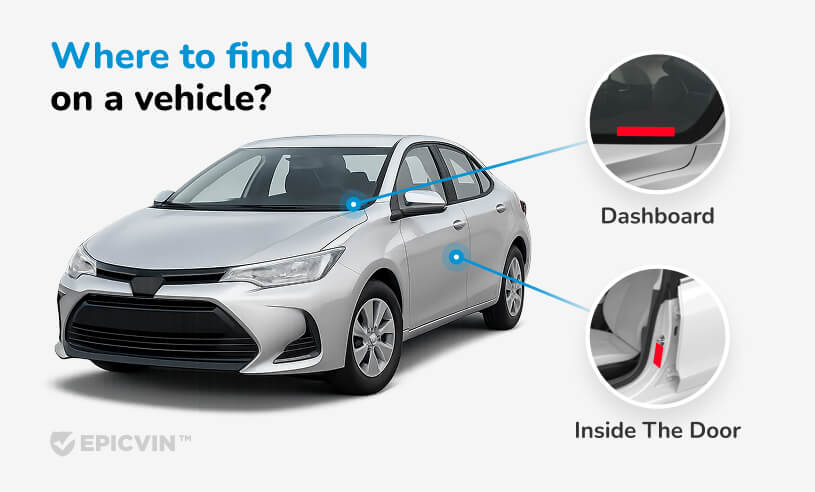
How to Read a VIN Number Like a Pro
From understanding the VIN number breakdown to uncovering a vehicle’s history,...

Free Isuzu VIN Decoder! 🚗 See specs, build sheet, recalls basic history—no sign-up. 🛡️✅ Need accidents, mileage, title? Upgrade in one click.
Looking for the VIN?
Here is there you’ll find it:

An Isuzu vehicle identification number (VIN) is a unique 17-character code assigned to every vehicle since 1981, following ISO Institute standards. Using our VIN decoder helps verify specifications, track recalls, and obtain detailed information about your truck or used car before purchase from the car market.
Decoding your Isuzu VIN provides instant access to manufacturer specifications and recall information.

Your Isuzu VIN appears in multiple locations for easy identification.
| Key Risk | Impact on Buyers | Mitigation Steps |
|---|---|---|
| Theft Risk | Commercial pickups have ~3% higher theft rate than average trucks. | Check VIN against NICB theft records. Confirm anti-theft features before purchase. |
| Unrepaired Safety Recalls | ~2% of Isuzu trucks still have open NHTSA recalls. | Run VIN through NHTSA recall lookup. Schedule free dealer repair immediately. |
| Depreciation Over Time | The N-Series loses ~25% of its value in the first 3 years. | Compare VIN-based market values with EpicVIN resale trends. Plan the total cost of ownership. |
| Odometer Rollback Fraud | ~1.5% of auctioned Isuzu trucks show tampering signs. | Use EpicVIN mileage checks with NMVTIS feeds. Review service records for consistency. |
| Hidden Flood or Salvage History | ~4% of used listings show potential flood or salvage events. | Verify VIN in NMVTIS and auction photo archives. Avoid "title-washed" units. |
Risk Reduction: How to minimize risks: Check your VIN report for recalls, mileage, and auction history. EpicVIN automatically identifies potential problems in seconds and cross-references stolen vehicle databases.
| Issue | Affected Models, Symptoms, Average Repair Cost |
|---|---|
| 4JJ1 Timing Chain Stretch | N Series diesel (2010–2017), ~125k mi; rattling front end. ~$1,200–$1,600 |
| Crankshaft Sensor Failure | 4JJ1 diesel (pre-2010); hard starts, stalling. ~$200–$400 |
| Weak CV Joints / Tie Rods | Trooper, Rodeo (1990s–2000s); vibration, clunk. ~$300–$500 |

Each character in your vehicle's unique sequence tells a specific story.
There are some other important details that Isuzu owners and buyers should know:
Here's how our Isuzu VIN decoder interprets a sample sequence (1GGCS1443W8658480):
| Symbols | Sample | What It Reveals |
|---|---|---|
| 1 | 1 | The United States as the country of origin |
| 2 | G | General Motors as a manufacturer partner |
| 3 | G | Medium-duty truck vehicle type |
| 4-8 | CS144 | Chassis configuration, engine type, GVWR class, and model series |
| 9 | 3 | Check digit for validation |
| 10 | W | 1998 model year |
| 11 | 8 | Janesville, Wisconsin assembly plant |
| 12-17 | 658480 | Individual vehicle serial number |
Year 2016
Make Isuzu
Model NPR
Fuel Type Diesel
Engine 3L In-Line IZ3 - 4JJ1-TC
Made in JAPAN
Votre VIN Isuzu révèle des spécifications complètes du véhicule et des dossiers d'historique avec des détails importants pour les acheteurs sur le marché automobile.
Nous indexons chaque nouveau VIN Isuzu le jour de sa vente - suivant automatiquement les camions, SUV et autres véhicules de la vente à la récupération pour prévenir la fraude.— Alex Black, CMO, EpicVIN
Search for the vehicle identification number in specific places. Tese are the windshield, driver's door jamb, engine bay, or registration documents for the 17-character code.
The first digit: "1" indicates Michigan assembly, while "J" shows Japan manufacture for imported models.
Positions 4-8 contain chassis specifications including gross vehicle weight rating and truck classification details.
Yes, our decoder cross-references commercial registration records and identifies fleet ownership history patterns.
The vehicle descriptor section (positions 4-8) contains body style codes differentiating chassis configurations.
The model code appears in positions 4-8; i-Series trucks used specific identifier codes before discontinuation.
Engine code position and model year (10th digit) together indicate EPA Tier 4 compliance improvements.
Our full report includes auction archives with photos, sale prices, and condition reports from major dealers.
Equipment codes in the descriptor section identify air brake, hydraulic, or ABS configurations for trucks and SUVs.
Engine code position links to parts databases showing 4JJ1, 6.0L gas, or electric component suppliers for vehicles manufactured by Isuzu Motors Limited.
Discover expert tips, news and advice on buying and maintaining used vehicles

From understanding the VIN number breakdown to uncovering a vehicle’s history,...

Trim level affects what features your car has — and what it's worth. Learn wha...

Here is a guide to walk you through the best ways to sell a car in 2023.